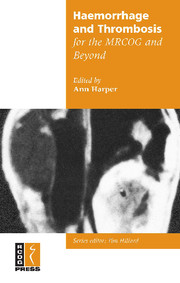Book contents
- Frontmatter
- Contents
- About the authors
- Abbreviations
- Preface
- 1 The coagulation system in pregnancy
- 2 Pregnancy in women with inherited bleeding disorders
- 3 Maternal and fetal thrombocytopenia
- 4 Massive obstetric haemorrhage
- 5 Disseminated intravascular coagulation
- 6 Gynaecological problems in women with bleeding disorders
- 7 Venous thromboembolism in obstetrics and gynaecology
- 8 Genetic thrombophilias and antiphospholipid antibodies
- Index
2 - Pregnancy in women with inherited bleeding disorders
Published online by Cambridge University Press: 05 October 2014
- Frontmatter
- Contents
- About the authors
- Abbreviations
- Preface
- 1 The coagulation system in pregnancy
- 2 Pregnancy in women with inherited bleeding disorders
- 3 Maternal and fetal thrombocytopenia
- 4 Massive obstetric haemorrhage
- 5 Disseminated intravascular coagulation
- 6 Gynaecological problems in women with bleeding disorders
- 7 Venous thromboembolism in obstetrics and gynaecology
- 8 Genetic thrombophilias and antiphospholipid antibodies
- Index
Summary
This chapter deals with the management of pregnancy and delivery in women who suffer from, or are carriers of, an inherited bleeding disorder such as von Willebrand's disease or haemophilia, or are female partners of affected men. These women should have prepregnancy counselling, including genetic counselling. If there is a possibility that they may require treatment with blood products and they are not already immune, they should also be immunised against hepatitis A and B. Pregnancy and delivery should be managed with close liaison between the obstetric and haematology teams, preferably allied with a haemophilia centre. Good communication and written protocols are important. Delivery should be in a maternity unit with ready access to blood and blood products and neonatal intensive care facilities.
Haemophilia
Haemophilia A is a congenital disorder of coagulation, characterised by deficiency of factor VIII in the blood. Deficiency of factor IX results in an identical clinical condition known as haemophilia B (also known as Christmas disease). Haemophilia is encountered in all racial groups, with an incidence of approximately one in 10 000. The clinical picture is dependent upon the degree of deficiency of the coagulation factor in the blood: severe haemophilia is associated with a level of less than 1% of normal. The hallmark of severe haemophilia is recurrent and spontaneous bleeding into joints, principally the knees, elbows and ankles. Repeated bleeding into joints can, in the absence of treatment, result in disabling arthritis at an early age.
Keywords
- Type
- Chapter
- Information
- Haemorrhage and Thrombosis for the MRCOG and Beyond , pp. 16 - 26Publisher: Cambridge University PressPrint publication year: 2005

